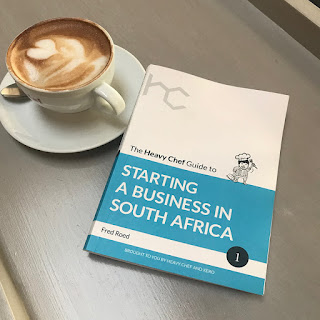The Heavy Chef Guide To Starting a Business - Internal Training Experiment (Part 5 - FINAL)
Welcome to Part 5 of the internal "entrepreneur training" series we're doing at forgood.
Using the Heavy Chef Guide to Starting a Business in South Africa (it's a super light read and presents quite a nice structure for the do's and don'ts of getting going in business) - we're doing bi-monthly learning sessions, discussions and exercises.
This is the last post. The final 4 chapters wrap up this "beginner's guide" quite nicely. It's been a fairly uncontroversial common sense read, so I was pleased to slightly disagree with one of the points. We'll get into that soon.
If you missed Part 1, Part 2, Part 3 and Part 4 - go give them a read. If you're wondering why we're training our team to be entrepreneurs? Why not?
Look beyond competitors being threats.
Sure, they can eat your lunch. But the modern business world demands a slightly more open and innovative approach to competitor analysis. Treat them as sources of information. Who do they talk to? How? What's their pricing? Do they feel different? Why?
You'll be surprised what you can learn and the tweaks you can make to your model/processes.
In the tech space, there is some honour in being copied, even though it doesn't feel like it when it happens. Real Time Wine was copied pixel for pixel by a local competitor within a few months. They failed - I like to appreciate the small things.
Even forgood has gone from 1 local direct competitor to 5 or 6 in a relatively short period of time - many of whom have likely drawn on what we've done. In fact, if they haven't drawn on the work we've done, we haven't been doing it well enough or loudly enough.
Business requires you to get emotional. Passion, commitment and grit are the most important ingredients. And yet, when it comes to competitors, it pays to keep some perspective and leverage the intelligence.
Remember, competitors often validate a market space. Let them do the work, just don't let them get away.
Not all marketing is created equal
There's an old saying. It's cheesy, but it's true more often that not.
You're going to try every marketing tactic under the sun. You'll fall for the allure of "growth hacking" - and then have a 360 degree swing back to tried-and-trusted-traditional. You'll focus on one channel and the blow it all wide open and go big on something through sheer FOMO.
I only have one piece of advice. Track your cost per acquisition. It's often tricky. It often leads to a rabbit hole of stats and some serious paralysis through analysis, but it's also the coldest slap of reality that marketing can give you.
What exactly does that sale cost you? And are you prepared to spend that?
We've had some good lessons at forgood figuring out what it costs to acquire a volunteer on the public volunteering site. Blended average across multiple channels is around R100/volunteer. There's always room for optimisation of course, but medium effort at reasonable budget tends to give us those results.
We then factor in that roughly 50% of volunteers tend to be high quality ones - that's a rough spend of R200 just to get someone "good" to volunteer. In a young ecosystem like South Africa, many would argue we'd do better just to give R200 straight to the Cause and be done with it.
These are the conversations you need to be having with your marketing team (or yourself). These are the questions you need to be asking. Nothing tells the truth like a real cost per acquisition. .
Keep your employees out of the drama. (Sometimes).
Finally I get to disagree with Fred. But first I'll disclaim there is some nuance.
Not every team member in a startup is interested in strategy or wants to know what your current frightening length of runway is. It's not that they want to stick their head in the sand, it's that you as the parent of the business see things differently.
You've heard that thing non-parents say about cute kids. Awesome to play with, but more awesome to hand back at the end of the day. I think your business has similar characteristics through the eyes of your team. They'll love it, they'll sweat for it - but a large percentage of them want to hand it back to you at the end of the day. If they didn't, they'd be founders.
That said, where I disagree with our esteemed author is team members being shielded from unpaid invoices. Especially if you have an account management / client service function - the speed and consistency of invoices is a critical piece of the puzzle.
A client that pays invoices consistently late doesn't respect you or the service you're providing. You can argue bureaucracy as much as you like - if you're mission critical to your customers - they'll pay you on time (most of the time).
As an account manager, you need to manage this part of the relationship. Not having sight of invoices and payment cycles is like having one eye closed. As a CEO, you need to instil some confidence into your account managers around chasing invoices. A business has every right to chase payment. Quite often, the people paying the bills are not your direct contacts (if you're worried about "harming" a relationship) - but even if they were, business works on the mutual exchange of value.
Don't let the power scales tip in the wrong direction. And keep both eyes open.
That's it, we're done. Hope you enjoyed our little exploration of entrepreneurship. No one has all the answers, but enjoy the journey and you'll bump into them!
Using the Heavy Chef Guide to Starting a Business in South Africa (it's a super light read and presents quite a nice structure for the do's and don'ts of getting going in business) - we're doing bi-monthly learning sessions, discussions and exercises.
This is the last post. The final 4 chapters wrap up this "beginner's guide" quite nicely. It's been a fairly uncontroversial common sense read, so I was pleased to slightly disagree with one of the points. We'll get into that soon.
If you missed Part 1, Part 2, Part 3 and Part 4 - go give them a read. If you're wondering why we're training our team to be entrepreneurs? Why not?
Chapters 7 to 10
Look beyond competitors being threats.
Sure, they can eat your lunch. But the modern business world demands a slightly more open and innovative approach to competitor analysis. Treat them as sources of information. Who do they talk to? How? What's their pricing? Do they feel different? Why?
You'll be surprised what you can learn and the tweaks you can make to your model/processes.
In the tech space, there is some honour in being copied, even though it doesn't feel like it when it happens. Real Time Wine was copied pixel for pixel by a local competitor within a few months. They failed - I like to appreciate the small things.
Even forgood has gone from 1 local direct competitor to 5 or 6 in a relatively short period of time - many of whom have likely drawn on what we've done. In fact, if they haven't drawn on the work we've done, we haven't been doing it well enough or loudly enough.
Business requires you to get emotional. Passion, commitment and grit are the most important ingredients. And yet, when it comes to competitors, it pays to keep some perspective and leverage the intelligence.
Remember, competitors often validate a market space. Let them do the work, just don't let them get away.
Not all marketing is created equal
There's an old saying. It's cheesy, but it's true more often that not.
You're going to try every marketing tactic under the sun. You'll fall for the allure of "growth hacking" - and then have a 360 degree swing back to tried-and-trusted-traditional. You'll focus on one channel and the blow it all wide open and go big on something through sheer FOMO.
I only have one piece of advice. Track your cost per acquisition. It's often tricky. It often leads to a rabbit hole of stats and some serious paralysis through analysis, but it's also the coldest slap of reality that marketing can give you.
What exactly does that sale cost you? And are you prepared to spend that?
We've had some good lessons at forgood figuring out what it costs to acquire a volunteer on the public volunteering site. Blended average across multiple channels is around R100/volunteer. There's always room for optimisation of course, but medium effort at reasonable budget tends to give us those results.
We then factor in that roughly 50% of volunteers tend to be high quality ones - that's a rough spend of R200 just to get someone "good" to volunteer. In a young ecosystem like South Africa, many would argue we'd do better just to give R200 straight to the Cause and be done with it.
These are the conversations you need to be having with your marketing team (or yourself). These are the questions you need to be asking. Nothing tells the truth like a real cost per acquisition. .
Keep your employees out of the drama. (Sometimes).
Finally I get to disagree with Fred. But first I'll disclaim there is some nuance.
Not every team member in a startup is interested in strategy or wants to know what your current frightening length of runway is. It's not that they want to stick their head in the sand, it's that you as the parent of the business see things differently.
You've heard that thing non-parents say about cute kids. Awesome to play with, but more awesome to hand back at the end of the day. I think your business has similar characteristics through the eyes of your team. They'll love it, they'll sweat for it - but a large percentage of them want to hand it back to you at the end of the day. If they didn't, they'd be founders.
That said, where I disagree with our esteemed author is team members being shielded from unpaid invoices. Especially if you have an account management / client service function - the speed and consistency of invoices is a critical piece of the puzzle.
A client that pays invoices consistently late doesn't respect you or the service you're providing. You can argue bureaucracy as much as you like - if you're mission critical to your customers - they'll pay you on time (most of the time).
As an account manager, you need to manage this part of the relationship. Not having sight of invoices and payment cycles is like having one eye closed. As a CEO, you need to instil some confidence into your account managers around chasing invoices. A business has every right to chase payment. Quite often, the people paying the bills are not your direct contacts (if you're worried about "harming" a relationship) - but even if they were, business works on the mutual exchange of value.
Don't let the power scales tip in the wrong direction. And keep both eyes open.
That's it, we're done. Hope you enjoyed our little exploration of entrepreneurship. No one has all the answers, but enjoy the journey and you'll bump into them!



Comments
Post a Comment